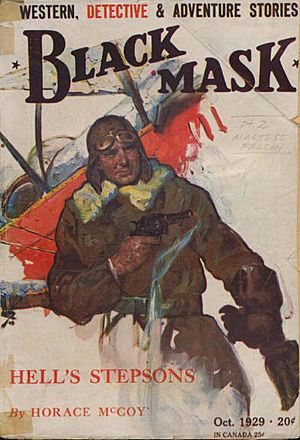Horace McCoy facts for kids
Quick facts for kids
Horace McCoy
|
|
|---|---|
| Born | Horace Stanley McCoy April 14, 1897 Pegram, Tennessee |
| Died | December 15, 1955 (aged 58) Beverly Hills, California |
| Occupation | Novelist |
| Nationality | American |
| Genre |
|
| Notable works | They Shoot Horses, Don't They? |
Horace Stanley McCoy (born April 14, 1897 – died December 15, 1955) was an American writer. He was famous for his exciting, "hardboiled" stories. Many of his books were set during the Great Depression, a time when many people faced tough economic challenges. His most well-known novel is They Shoot Horses, Don't They?, published in 1935. This book was later made into a popular movie in 1969.
Contents
About Horace McCoy
Early Life and War Service
Horace McCoy was born in Pegram, Tennessee. When he was a young man, he served in the United States Army Air Corps during World War I. He flew many important missions behind enemy lines. His jobs included being a bombardier, which meant dropping bombs from planes. He was also a reconnaissance photographer, taking pictures to gather information about the enemy.
During his service, McCoy was wounded. He received a special award for bravery from the French government called the Croix de Guerre.
Life After the War
After the war, from 1919 to 1930, McCoy worked as a sports editor for a newspaper called the Dallas Journal in Texas. He even did the play-by-play for a baseball game on the radio in 1924, which was quite new at the time!
In the late 1920s, he started writing short stories. These stories were published in different "pulp" mystery magazines. Pulp magazines were popular because they were cheap and had exciting, adventurous stories.
McCoy also enjoyed acting. He performed with the Dallas Little Theater and had important roles in several plays. A newspaper once called him a "sort of enfant terrible" because he was so energetic and talented in both journalism and acting.
Moving to Hollywood
In 1931, the director of the Dallas Little Theater, Oliver Hinsdell, moved to Hollywood to become an acting coach for MGM, a big movie studio. Horace McCoy decided to follow him, hoping to become a film actor.
He appeared in a short movie called "The Hollywood Handicap" in 1932. However, he soon started working more on writing movie scripts, which is called screenwriting.
While trying to make it in Hollywood, McCoy took on many different jobs. He washed cars, picked lettuce in the Imperial Valley, and even worked as a bouncer at a pier in Santa Monica.
Writing Novels and Movies
His experience as a bouncer gave him the idea for his most famous novel, They Shoot Horses, Don't They?. This book tells the story of a tough dance marathon during the Great Depression.
Another one of his novels, I Should Have Stayed Home, was about a young actor from the South trying to find work in Hollywood in the 1930s. His book No Pockets in a Shroud featured a brave reporter as the main character.
In 1948, McCoy published another "hard-boiled" classic called Kiss Tomorrow Goodbye. This story is told by the main character, Ralph Cotter, who doesn't care much about right or wrong. This book was also made into a James Cagney movie. Horace McCoy's writing style even influenced some famous French filmmakers who loved his crime stories.
In Hollywood, McCoy wrote many different types of movies. He wrote westerns, crime stories, and other films for various studios. He worked with well-known movie directors like Henry Hathaway and Raoul Walsh. He also helped with the script for the famous movie King Kong in 1933, though he wasn't officially credited.
The movie Bad for Each Other (1953) was based on his novel Scalpel (1952). He also received credit for the story of a character named Samantha Crawford in the TV series Maverick.
Personal Life
Horace McCoy was married to Helen Vinmont McCoy. They had two sons, Horace Stanley McCoy II and Peter McCoy, and a daughter, Amanda McCoy. He passed away in Beverly Hills, California, from a heart attack.
Works
Novels
- They Shoot Horses, Don't They? (1935)
- No Pockets in a Shroud (1937; revised 1948)
- I Should Have Stayed Home (1938)
- Kiss Tomorrow Goodbye (1948)
- Scalpel (1952)
- Corruption City (unfinished; completed by a ghostwriter and published posthumously in 1959)
Short stories
All-Star Detective Stories":
- "Two Smart Guys" (November 1931)
Black Mask:
- "The Devil Man" (December 1927)
- "Dirty Work" (September 1929)
- "Hell's Stepsons" (October 1929)
- "Renegades of the Rio" (December 1929)
- "The Little Black Book" (January 1930)
- "Frost Rides Alone" (March 1930)
- "Somewhere in Mexico" (July 1930)
- "The Gun-Runners" (August 1930)
- "The Mailed Fist" (December 1930)
- "Headfirst into Hell" (May 1931)
- "The Mopper Up" (November 1931)
- "The Trail to the Tropics" (March 1932)
- "The Golden Rule" (June 1932)
- "Murder in Error" (August 1932)
- "Wings Over Texas" (October 1932)
- "Flight at Sunrise" (May 1934)
- "Somebody Must Die" (October 1934
Detective-Dragnet Magazine:
- "Killer's Killer" (December 1930)
- "Death Alley" (March 1931)
- "Juggernaut of Justice" (August 1931)
Detective Action Stories:
- "Night Club" (February 1931)
Man Stories:
- "A Matter of Honor" (July 1931)
Nickel Detective:
- "Trapped By Silver" (August 1933)
Popular Fiction:
- "Bombs for the General" (February 1932)
See also
 In Spanish: Horace McCoy para niños
In Spanish: Horace McCoy para niños


